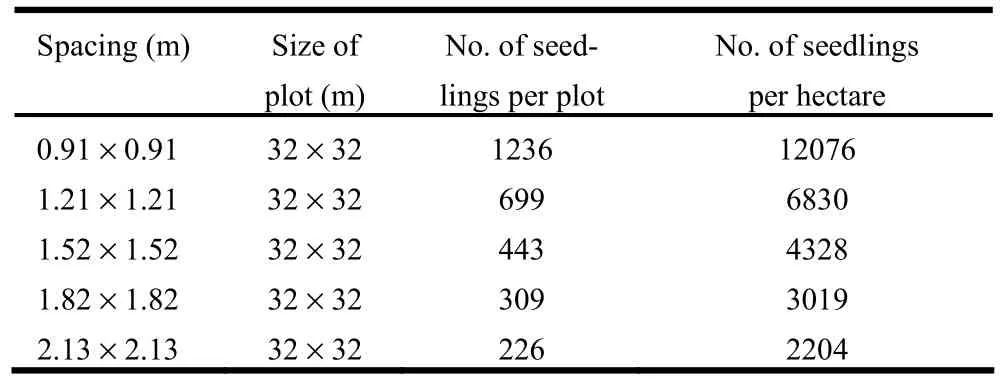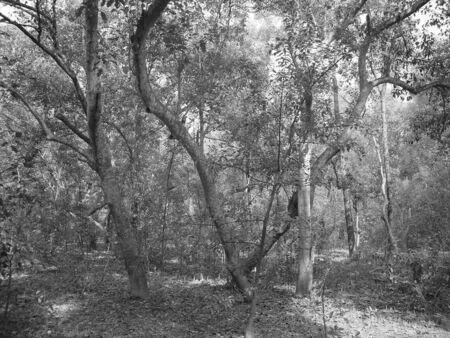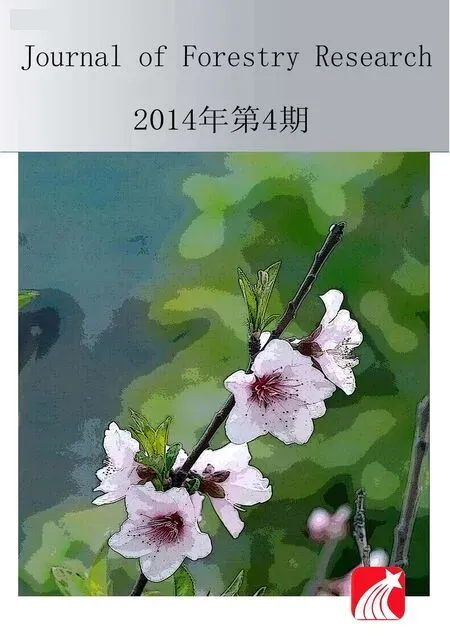Growth performance of Avicennia officinalis L. and the effect of spacing on growth and yield of trees planted in the Western coastal belt of Bangladesh
Md. Abdul Quddus Miah · Sk. Ahiul Islam · Md. Ahsan Habib Md. Golam Moula
ORIGINAL PAPER
Growth performance of Avicennia officinalis L. and the effect of spacing on growth and yield of trees planted in the Western coastal belt of Bangladesh
Md. Abdul Quddus Miah · Sk. Ahiul Islam · Md. Ahsan Habib Md. Golam Moula
Received: 2013-12-09 Accepted: 2014-04-15
© Northeast Forestry University and Springer-Verlag Berlin Heidelberg 2014
A trial of Avicennia officinalis L. with five different spacings was conducted in the newly accreted lands along the western coastline (Patuakhali district) of Bangladesh since 1993 to assess growth performance and the effect of spacing on tree growth. Data on tree density, height, diameter, bole height, crown diameter were recorded and analyzed when the stand was 19 years old. Mean height ranged from 12.89−13.52 m and diameter at breast height (dbh) from 26.57−32.16 cm in plots of different spacings. The mean annual height increment ranged from 0.67−0.71 m, mean annual diameter increment from 1.40-1.69 cm and wood volume from 6.02−10.04 m3·ha-1·a-1in different treatments. Significantly greater diameter (32.16 cm) and wood volume (10.04 m3·ha-1·a-1) were obtained with wider (2.13 m × 2.13 m) spacing than with closer spacings. But tree growth was unaffected by other spacings. Growth data were also recorded from other A. officinalis plantations raised by Forest Department (FD) on different islands in Patuakhali and Bhola districts of Bangladesh. At these sites, mean annual height increment ranged from 0.33−0.62 m, mean annual diameter increment from 0.72−1.37 cm and wood volume from 1.55−5.73 m3·ha-1·a-1. The growth performance of A. officinalis indicated that the newly accreted lands along the western shoreline may be suitable for raising Avicennia plantations for the enrichment of coastal vegetation.
s: growth, Avicennia officinalis, plantation, spacing, coastal belt.
Introduction
The Bangladesh coastline extends over 710 km long along the Bay of Bengal and is comprised of various forms of accreted (char) lands and off-shore islands (Siddiqi 2001a). Every year newly accreted lands are added in the coastal belt. Bangladesh Forest Department has created productive and protective mangrove vegetation in the coastal belt with the primary objective of saving lives and properties of coastal dwellers from cyclones and tidal bores (Das and Siddiqi 1985). The objectives of coastal afforestation were then expanded to stabilization of newly accreted lands and enhancement of accretions, and development of forest for timber and fuel wood. Initially, most of the commercial mangrove species were planted on newly accreted lands periodically inundated by tides. Sonneretia appetela Buch.-Ham. (keora) is the most successful planted species along the shoreline and Avicennia officinalis L. (baen) is the second most successful species of the coastal mangrove plantations on newly accreted lands (Siddiqi 2001a). Approximately 190,000 ha of accreted lands have been brought under coastal mangrove plantations till 2010 (Islam et al. 2013). A. officinalis alone accounts for about 5% of the total mangrove plantations and 22% in the eastern part (Chittagong and Cox’s Bazar) of the shoreline (Siddiqi 2001b).
A. officinalis a mangrove tree species of the early phase of ecological succession and usually colonizes after S. apetala in the Sundarbans of Bangladesh (Siddiqi 2001a). A. officinalis generally occurs as scattered and isolated trees in the inner part of the Sundarbans. It is a big tree, attaining heights of 10-15 m. The canopy is usually wide and occupies a large area. Wood of this species is used for construction, rough walling of houses, furniture accessories, rice pounders and tool handles. Logs and branches are used as fuel wood and as anchors. Leaves are used as fodder and resin from bark as a contraceptive.
A. officinalis has been planted since 1969 on the coastal belt of Bangladesh at a spacing of 0.90 m×0.90 m and 1.2 m ×1.2 m (Latif et al. 1994). The growth performance of baen on the eastern coastal belt has been promising (Alam and Siddiqi 2012) but its performance on other parts of the coastline has not been well documented. No systematic study has been carried out on the growth performance of A. officinalis in the western coastal areas. In addition, the optimal spacing for planting the species has not been determined. To fill these gaps in mangrove plantation technology, we conducted a trial in 1993 to observe the growth performance and the effect of spacing on growth and yield of this species in the western coastal belt of Bangladesh.
Materials and methods
The Plantation Trial Unit Division of Bangladesh Forest Research Institute established an experiment in the newly accreted (char) lands at Madarbunia, Rangabali island of Patuakhali district, Bangladesh. Rangabali island is located at 21°92′ N and 90°45′ E. The area forms the lowest landmass and is part of the delta of the extended Himalayan drainage ecosystem. The landscape has been formed by the combined actions of rivers Meghna, Brahmaputra and Ganges. The landscape is low-lying land, estuaries and inlands along the seacoast. The tidal floodplain has a distinctive, almost level landscape crossed by innumerable interconnecting tidal rivers and creeks. The estuarine islands are constantly changing shape and position as a result of river erosion and new alluvial deposition. The area is subject to flooding in the monsoon season. Tides are semi-diurnal and mean tide ranges from 2.2−4.0 m. In monsoon, water salinity ranges from 0.3−2.7% while in the dry season it ranges from 1.0−3.3% (Siddiqi and Khan 1990). Soil salinity varies remarkably between the monsoon and dry seasons. Soil salinity ranges from 0.3−4.2 dS·m-1in December and reaches its peak from April-May when average salinity is as high as 9 dS·m-1(Hasan 1987). Soil pH is slightly or moderately alkaline (7.5−8.0). Soil of the site is non-calcareous, grey floodplain and silt-clay-loam. Mean organic carbon in the soil is 1.4% and mean nitrogen content is 0.09%. The climate is humid. Temperatures range between 18 and 32°C. Annual rainfall varies from 2500−3000 mm (Siddiqi 2002). The experimental site was plain and gentle slope on the canal bank and the site was inundated throughout the year when the experiment was initiated.
Seeds of A. officinalis were collected from the Sundarbans during August-September. Seedlings were raised in polybags of size 25 cm×15 cm fillee with powdered soil and cowdung mixture at a ratio of 3:1. Seedlings were maintained in the nursery for about 10 months. Eight to ten month old polybag seedlings were planted at five spacings, 0.91 m × 0.91 m, 1.21 m×1.21 m, 1.52 m × 1.52 m, 1.82 m×1.82 m and 2.13 m × 2.13 m. The experiment was laid out in Randomized Complete Block Design (RCBD) with 3 replications. A total of 15 plots were established and the size of each plot was 32 m × 32 m. The total area of the experiment was 1.54 hectare. Totals of 1236, 699, 443, 309 and 226 seedlings were planted in each plot at the above listed spacings respectively (Table 1). Data on tree density, height, diameter at breast height (dbh), bole height and crown diameter were collected in March 2013 when stand age was 19 years (Fig. 1). The volume of standing trees was calculated following an Avicennia volume table (Latif et al. 1994).

Table 1: Experimental design of A. officinalis spacing trial for planting in the newly accreted land at Rangabali island.

Fig. 1: A. officinalis (19 years old) plantation at Rangabali island of the western coastal belt of Bangladesh
Bangladesh Forest Department also raised some A. officinalis plantations at 1.2 m×1.2 m spacing at Mujib killa and Muslim para of Char Kukri-Mukri in Bhola district, and Char Kashem of Rangabali island in Patuakhali district, Bangladesh. These plantations were established in 1975, 1976, 1977 and 1990 at Mujib killa (1), Muslim para, Mujib killa (2) and Char Kashem respectively. Three Temporary Sample Plots (TSP) of 30 m×25 m from each plantation and thus a total of 12 TSPs were established at the four locations. Additional data on growth characteristics were collected at these plantations for comparison with experimental plantations. All these data were analyzed using Excel spreadsheet and Minitab statistical package. Analysis of variance (ANOVA) was used to determine the effect of spacings on tree height, diameter, bole height, crown diameter and wood volume.
Results and discussion
The growth performance of 19 years old A. officinalis was analyzed and the mean values for different parameters are given in Table 2.
The highest stocking rate of trees per hectare was 552 for 1.52 m × 1.52 m spacing and the lowest rate was 458 for 1.82 m×1.82 m spacing. The survival per unit area was very poor at 19 yearsafter planting. Many of the planted seedlings had disappeared or died at the initial stage of plantation. Many factors were responsible for low seedling survival. These were flooding by high tidal inundation during the monsoon, sedimentation of the planting sites, lacking of seedling maintenance and grazing by domestic animals, including buffalo and cattle. Moreover cyclones from the Bay of Bengal sometimes directly hit the coastal belt with the result that many seedlings were damaged or died at the early stage.
Tree height ranged from 12.89−13.52 m, bole height from 3.34−3.58 m and diameter at breast height (dbh) from 26.57−32.16 cm for the five plantation spacings. The mean annual increment (MAI) in height varied from 0.67−0.71 m while MAI in diameter was 1.40−1.69 cm for the five spacings. The wood volume increment ranged from 6.02−10.04 m3·ha-1·a-1among the treatments (Table 2). Tree height did not differ by spacing but dbh, crown diameter and volume increment did. DBH was significantly greater (32.16 cm) for the widest (2.13 m×2.13 m) spacing than for other closer spacings. Significantly higher volume increment (10.04 m3·ha-1·a-1) was also recorded for the widest than the closer spacings (Table 2). But no significant variation was recorded for height, dbh, bole height or wood volume between the other 4 closer spacings (1.82 m×1.82 m, 1.52 m×1.52 m, 1.21 m×1.21 m and 0.91 m×0.91 m).This was probably due to more or less similar tree density in these plots after a certain period of plantation because of losses of seedlings. A total of 2561, 3776, 6353, 11566 seedlings per hectare area were lost in above 4 closer spacings but 1711 seedlings were lost in widest spacing plantation. Although significant variations on tree density per hectare area were found between 1.52 m × 1.52 m and 2.13 m × 2.13 m spacing but no variations were found between most closer (0.91 m × 0.91 m and 1.21 m × 1.21 m) and the widest (2.13 m × 2.13 m) spacings.
In comparison to other plantations raised by Forest Department, the growth of 21−37 year-old A. officinalis plantations at four different locations of the coastal belt were analyzed and are shown in Table 3. The highest stocking was 383 trees·ha-1at Mujib killa (1) and the lowest was 240 trees·ha-1at Mujib killa (2). The tallest trees were 13.15 m, and greatest dbh was 28.96 cm at Char Kashem and the shortest trees were 11.84 m and the smallest dbh was 25.80 cm at Mujib killa (1). The greatest annual height increment was 0.62 m and diameter increment was 1.37 cm at Char Kashem. The average tree density for all sites was 297 trees·ha-1. The overall average tree height was 12.76 m, the bole height was 5.96 m and the mean annual height increment was 0.41m. Overall dbh was 27.01 cm and mean diameter increment was 0.88 cm. The production of wood was 2.96 m3·ha-1·a-1(Table 3).

Table 2: Growth of A. officinalis at the age of 19 years after planting at Rangabali island of the western coastal belt of Bangladesh

Table 3: Growth of A. officinalis plantations raised by Forest Department at different locations of the western coastal belt of Bangladesh
The results from both experimental and FD plantations showed low tree density but greater stocking was recorded in research plots than FD plantations. The average surviving tree density was 498 trees·ha-1in the research plantations while it was only 297 trees·ha-1in FD plantations. The average height, dbh and wood production were higher in the research plots than in FD plantations. In previous studies, A. officinalis grew well in the eastern coastal belt of Bangladesh where salinity levels are high. But the present study showed promising growth performance and yield in the western coastal belt that was higher than inthe eastern coastal belt. The highest yield of A. officinalis was 10.04 m3·ha-1·a-1in the western coastal belt whereas it was 6.9 m3·ha-1·a-1in eastern coastal belt.
In the present study, tree height, dbh and wood production were higher in 2.13 m × 2.13 m plots than in other closer spacings. Traditionally the Forest Department raises A. officinalis plantation along the coastline at 1.21 m × 1.21 m spacing. Large quantities of seedlings (6849 seedlings·ha-1) are needed for plantations at 1.21 m × 1.21 m spacing whereas only 2207 seedlings·ha-1are needed at 2.13 m × 2.13 m spacing. The expenditure for raising seedlings and plantations is very high at closer spacings. So, a wider spacing such as 2.13 m × 2.13 m is preferable financially to other closer spacings used in this experiment. Our results revealed that planting at 2.13 m × 2.13 m spacing was more suitable than closer spacings for raising plantation of this species in the coastal belt. Planting at this wider spacing would reduce expenditures for raising large scale plantations.
Conclusions
A. officinalis is the second pioneer species in the newly accreted lands in the natural mangroves of Bangladesh. Artificial regeneration using this species in the coastal areas was more successful only in the eastern coastline. But there were some plantations in the western coastline with very low survival. The trial plantations showed low survival but tree height and diameter growth were satisfactory although the spacings had no remarkable effect on growth performance. The mortality rate was very high at the initial stage of plantation. If plantations can be raised with polybag seedlings on suitable sites and special care can be taken in the initial stage of establishment, it is possible to successfully raise A. officinalis plantation. Therefore, we recommend that plantations be raised in the newly accreted lands along western shorelines at wider spacing rather than closer spacings. This will help in planning for planting of A. officinalis, a valuable mangrove species in the newly accreted lands of the coastline of Bangladesh.
Alam MJ, Siddiqi NA. 2012. Comparative growth of Avicennia officinalis L., A. marina (Forsk.) Vierh. and A. alba Bl. in the eastern shorelines of Bangladesh. Bangladesh Journal of Forest Science, 32(1): 62−67.
Das S, Siddiqi NA. 1985. The Mangroves and Mangrove Forests of Bangladesh. Mangrove Silviculture Division. Bulletin No. 2, Chittagong: Bangladesh Forest Research Institute, p. 142.
Hasan MM. 1987. Preliminary report on coastal afforestation sites. In: Drigo R, Latif MA, Chowdhury JA, Shaheduzzaman M (eds.), The Maturing Mangrove Plantations of the Coastal Afforestation Project. FAO/UNDP Project, BGD/85/085. Field Document No. 2, Mohakhali, Dhaka: Bangladesh Forest Department, pp. 64−66.
Islam SA, Miah MAQ, Habib MA, Moula MG, Rasul MG. 2013. Growth performance of underplanted mangrove species in Sonneratia apetala (Keora) plantations along the western coastal belt of Bangladesh. Bangladesh Journal of Forest Science, 32(2): 26−35.
Latif MA, Das S, Rahman MF, Chowdhury JA. 1994. Tree Volume Tables for Baen (Avicennia officinalis) in the Coastal Plantations of Bangladesh. Bulletine 8, Forest Inventory Division, Chittagong: Bangladesh Forest Research Institute, pp. 21−32.
Siddiqi NA. 2001a. Mangrove Forestry in Bangladesh. Institute of Forestry & Environmental Science: University of Chittagong, p. 201.
Siddiqi NA. 2001b. Creating second rotation crops in the existing keora (Sonneratia apetala) plantations. In: Siddiqi NA, Baksha M W (eds), Mangrove Research and Development. Chittagong: Bangladesh Forest Research Institute, pp. 102−107.
Siddiqi NA. 2002. Development and sustainable management of coastal plantations in Bangladesh. Journal of Asiatic Society of Bangladesh (Science), 28(2): 144−166.
Siddiqi NA, Khan MAS. 1990. Growth performance of mangrove trees along the coastal belt of Bangladesh. Mangrove Ecosystems Occasional Papers. No. 8. UNDP/UNESCO REGIONAL MANGROVES PROJECT RAS/86/120, New Delhi, India: Thomson Press, pp. 5−14.
DOI 10.1007/s11676-014-0531-5
The online version is available at http:// www.springerlink.com
Md. Abdul Quddus Miah, Sk. Ahiul Islam(), Md. Ahsan Habib, Md. Golam Moula
Plantation Trial Unit Division, Bangladesh Forest Research Institute, Rupatoli, Barisal-8206, Bangladesh.
E-mail: ahiulislam@yahoo.com; Telephone: 88-0431-71617
Corresponding editor: Zhu Hong
 Journal of Forestry Research2014年4期
Journal of Forestry Research2014年4期
- Journal of Forestry Research的其它文章
- Growth and yield of two grain crops on sites former covered with eucalypt plantations in Koga Watershed, northwestern Ethiopia
- Carbon stock in Korean larch plantations along a chronosequence in the Lesser Khingan Mountains, China
- Biomass accumulation and nutrient uptake of 16 riparian woody plant species in Northeast China
- Cloning and sequence analysis of nine novel MYB genes in Taxodiaceae plants
- Genetic and morphological variation in natural teak (Tectona grandis) populations of the Western Ghats in Southern India
- Improved salt tolerance of Populus davidiana × P. bolleana overexpressed LEA from Tamarix androssowii
